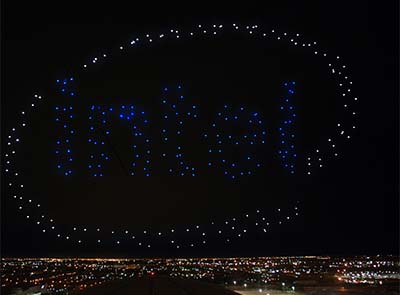A spectacular drone light show stole the show at Lady Gaga’s halftime performance at last night’s Super Bowl.
Three hundred Intel Shooting Star drones lit up the sky in a choreographed aerial performance marking the first-ever drone integration during a televised event at the Pepsi Zero Sugar Super Bowl.
Intel collaborated with the NFL, Pepsi and six Lady Gaga to flight the show.
As Lady Gaga’s performance began, Intel Shooting Star drones created a backdrop of colorful formations in the sky including twinkling stars that transformed into red and blue moving stars, before creating the American flag for a dramatic finale that brought Lady Gaga to centre stage on the field.
The Intel Shooting Star drones then finished out the halftime performance by forming the Pepsi logo in the sky.
“Lady Gaga and the Super Bowl creative team wanted to pull off something that had never been done before and we were able to combine Intel drone innovation with her artistry to pull off a truly unique experience,” says Josh Walden, senior vice-president and GM of the new technology group at Intel.
“The potential for these light show drones is endless and we hope this experience inspires other creatives, artists and innovators to really think about how they can incorporate drone technology in new ways that have yet to even be thought of.”
At the conclusion of the Pepsi Zero Sugar Super Bowl LI Halftime Show, Intel also ran a 10-second spot featuring the Intel Shooting Star drones morphing from the Pepsi logo into the Intel logo.
The Intel Shooting Star drones are a new type of unmanned aerial vehicle (UAV), specifically designed for entertainment purposes such as festivals and entertainment events. The purpose-built quadcopter drone is built with safety in mind and equipped with LED lights that can create over 4-billion color combinations and easily be programmed for any animation.
Pictured: An Intel Shooting Star drones fleet lights up the sky in the Intel logo following the Pepsi Zero Sugar Super Bowl LI Halftime Show on Sunday 5 February.
Credit: Intel Corporation

